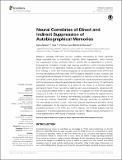Files in this item
Neural correlates of direct and indirect suppression of autobiographical memories
Item metadata
| dc.contributor.author | Noreen, Saima | |
| dc.contributor.author | O'Connor, Akira Robert | |
| dc.contributor.author | MacLeod, Malcolm David | |
| dc.date.accessioned | 2016-03-21T10:30:04Z | |
| dc.date.available | 2016-03-21T10:30:04Z | |
| dc.date.issued | 2016-03-18 | |
| dc.identifier | 241308178 | |
| dc.identifier | 4a18cfd0-22f2-4ec6-a940-768aeb852af3 | |
| dc.identifier | 84963704918 | |
| dc.identifier | 000443465400001 | |
| dc.identifier.citation | Noreen , S , O'Connor , A R & MacLeod , M D 2016 , ' Neural correlates of direct and indirect suppression of autobiographical memories ' , Frontiers in Psychology , vol. 7 , 379 . https://doi.org/10.3389/fpsyg.2016.00379 | en |
| dc.identifier.issn | 1664-1078 | |
| dc.identifier.other | ORCID: /0000-0002-7943-5183/work/34028962 | |
| dc.identifier.uri | https://hdl.handle.net/10023/8446 | |
| dc.description | We would like to acknowledge The British Academy Leverhulme Research Grant in supporting this research (grant reference number –SG121177). | en |
| dc.description.abstract | Research indicates that there are two possible mechanisms by which particular target memories can be intentionally forgotten. Direct suppression, which involves the suppression of the unwanted memory directly, and is dependent on a fronto-hippocampal modulatory process, and, memory substitution, which includes directing one's attention to an alternative memory in order to prevent the unwanted memory from coming to mind, and involves engaging the caudal prefrontal cortex (cPFC) and the mid-ventrolateral prefrontal cortex (VLPFC) regions. Research to date, however, has investigated the neural basis of memory suppression of relatively simple information. The aim of the current study was to use fMRI to identify the neural mechanisms associated with the suppression of autobiographical memories. In the present study, 22 participants generated memories in response to a series of cue words. In a second session, participants learnt these cue-memory pairings, and were subsequently presented with a cue word and asked either to recall (think) or to suppress (no-think) the associated memory, or to think of an alternative memory in order to suppress the original memory (memory-substitution). Our findings demonstrated successful forgetting effects in the no-think and memory substitution conditions. Although we found no activation in the dorsolateral prefrontal cortex there was reduced hippocampal activation during direct suppression. In the memory substitution condition, however, we failed to find increased activation in the cPFC and VLPFC regions. Our findings suggest that the suppression of autobiographical memories may rely on different neural mechanisms to those established for other types of material in memory. | |
| dc.format.extent | 18 | |
| dc.format.extent | 1202564 | |
| dc.language.iso | eng | |
| dc.relation.ispartof | Frontiers in Psychology | en |
| dc.subject | Think/no-think | en |
| dc.subject | Memory retrieval | en |
| dc.subject | Direct suppression | en |
| dc.subject | fMRI | en |
| dc.subject | Autobiographical memories | en |
| dc.subject | RC0321 Neuroscience. Biological psychiatry. Neuropsychiatry | en |
| dc.subject | BF Psychology | en |
| dc.subject | NDAS | en |
| dc.subject.lcc | RC0321 | en |
| dc.subject.lcc | BF | en |
| dc.title | Neural correlates of direct and indirect suppression of autobiographical memories | en |
| dc.type | Journal article | en |
| dc.contributor.institution | University of St Andrews. School of Psychology and Neuroscience | en |
| dc.identifier.doi | 10.3389/fpsyg.2016.00379 | |
| dc.description.status | Peer reviewed | en |
| dc.identifier.url | http://journal.frontiersin.org/article/10.3389/fpsyg.2016.00379/abstract | en |
This item appears in the following Collection(s)
Items in the St Andrews Research Repository are protected by copyright, with all rights reserved, unless otherwise indicated.

